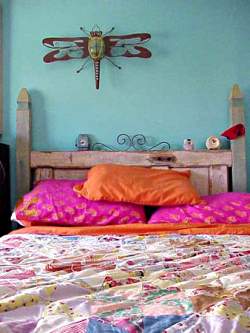If you could design the ideal bedroom, it would be large enough to hold whatever size bed you desire, with ample room for modern furniture and accessories. Unfortunately, many times the case is just the opposite; once the bed is chosen and in place, you’re faced with trying to fit everything else into the remaining space without overcrowding.
Taking time to plan can help you to foresee any possible space usage problems. Begin by surveying your existing bedroom, then analyze your options for improvement. Study the layout of the space and think about how it can work best for you. A good design is practical and comfortable, as well as stylish.
Because the bed is usually the largest item in the room, its location is critical to making the most effective use of the space. Traffic patterns begin and end at the bed. The location of other areas, such as a dressing or sitting area, will then evolve from the bed’s placement. Start experimenting with your floor plan options by trying various modern furniture arrangements on paper instead of trying to push heavy furniture around the room.
Try to imagine being in your bedroom with the type of bed you want, placed where you think it works best. Does this new floor plan make the most efficient use of floor space?
Think about what you will see from the bed. Will morning light waken you or glare into your eyes? Allow enough clearance in places where a door swings inward or a drawer pulls open. Be sure to allow enough clearance above the bed as well, especially with a platform bed. Four feet of headroom is the minimum that should be allotted.
To create the illusion of a larger space, avoid clutter. Keep as much floor area open as possible. Placing the bed in a corner is one way to make the rest of the floor area seem larger. A studio apartment or a small bedroom can double as a sitting room by using a sofa bed, futon couch or daybed (a bed with two ends) rather than a conventional bed.
The guidelines for bedroom furniture arrangements are more flexible because these rooms don’t have as much traffic as other rooms. These guidelines allow you to use some tricks to help make a bedroom more useful. Beds can be free-standing, positioned with one end or side against the wall, angled into the room, or tucked into a corner or a special niche. If you’re dealing with limited floor space or a seldom-used guest room, a loft bed, bunk bed, Murphy bed, trundle or other built-in may be the answer.
 Minimalists are so tidy by nature that they do not actually need much space to accommodate them. Hoarders will have to work much harder to find space for all their things, and will need to devise ingenious storage systems if you ere a hoarder, you might consider designating one room for most of your possessions, so that you can keep the main living areas spacious and free from clutter.
Minimalists are so tidy by nature that they do not actually need much space to accommodate them. Hoarders will have to work much harder to find space for all their things, and will need to devise ingenious storage systems if you ere a hoarder, you might consider designating one room for most of your possessions, so that you can keep the main living areas spacious and free from clutter.
 Keep in mind that walls, floors and other elements in a bedroom also have textures that add to the ambience of a room. A smooth brass headboard contrasts nicely with a tapestry bedspread. Polished hardwood flooring provides a beautiful surface that sets off a plush area rug perfectly. Effectively combining patterns to create a desired bedroom decor can be a bit confusing and somewhat intimidating. Today, many textile manufacturers are making things easier for their customers by offering such coordinating elements as fabric and wallpaper together, to make the whole process easier.
Keep in mind that walls, floors and other elements in a bedroom also have textures that add to the ambience of a room. A smooth brass headboard contrasts nicely with a tapestry bedspread. Polished hardwood flooring provides a beautiful surface that sets off a plush area rug perfectly. Effectively combining patterns to create a desired bedroom decor can be a bit confusing and somewhat intimidating. Today, many textile manufacturers are making things easier for their customers by offering such coordinating elements as fabric and wallpaper together, to make the whole process easier.
